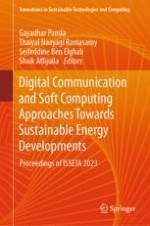2024 | Book
Digital Communication and Soft Computing Approaches Towards Sustainable Energy Developments
Proceedings of ISSETA 2023
Editors: Gayadhar Panda, Thaiyal Naayagi Ramasamy, Seifeddine Ben Elghali, Shaik Affijulla
Publisher: Springer Nature Singapore
Book Series : Innovations in Sustainable Technologies and Computing
